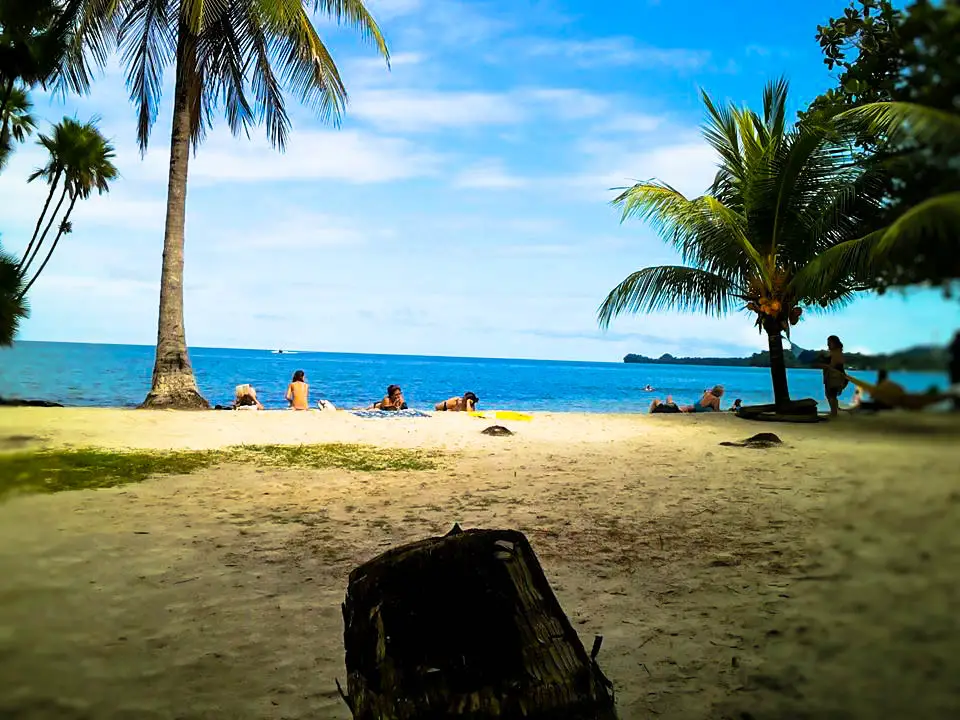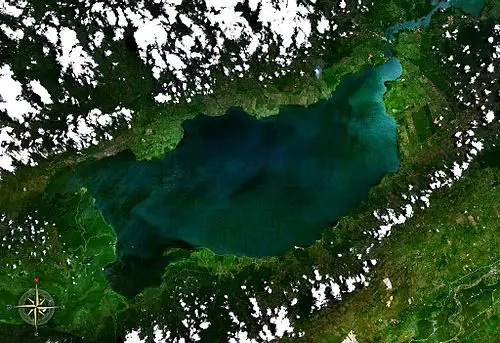Guatemala is a beautiful country located in Central America. With amazing people and covered by volcanoes, rainforests, and ancient Mayan sites, the country receives thousands of tourists every year. The main attraction for travelers is probably the paradisiac beaches. But some may wonder if these beaches are safe, bringing the question: Are there sharks in Guatemala?
There are at least 13 shark species confirmed to be in Guatemala. The Bull Shark, one of the 13 species, was found in Lake Izabal (freshwater). However, only one shark attack was ever reported in Guatemala, and predatory fishing makes sharks way more prey than hunters in the country.
Sharks are all over the world, and Guatemala is no different. The main species of sharks in the country are found in the South Pacific Ocean and the Caribbean Sea. However, there is an official confirmation of Bull Sharks found in Lake Izabal, a freshwater lake in Guatemala connected to the Caribbean sea by Rio Dulce.
In this article, you’ll find a detailed guide listing all the shark species in Guatemala. Plus, the story behind the only shark attack registered in the country on December 14, 1952, with 4 fatal victims. Finally, you’ll be able to find out the details about the Bull Sharks found in freshwater in Lake Izabal.
To learn all about sharks in Guatemala, read on.
Are There Sharks In Guatemala? (Species Guide)

Guatemala is a privileged country in terms of location, just south of Mexico, and natural wealth, with beautiful landscapes and true hidden gems, the country’s most popular tourist destinations are usually volcanoes, rainforests, and ancient Mayan sites. If this was not enough, the country also has borders with both the South Pacific Ocean and the Caribbean Sea, which means paradisiac beaches. But also sharks.
There are at least 13 species of shark living near Guatemala, whether in the Pacific, the Caribbean Sea, or even in a famous freshwater lake near the country’s eastern border. Unfortunately, predatory fishing is a massive problem in this nation. Sharks are salted and sold as other types of fish, and the government and ecologists are trying to avoid a disaster.
The most common species are the Silky Shark and the Whitenose Shark. Unfortunately, it is precisely the fact that they are abundant in the region that these two species are the most fished and endangered in the country. In addition to these two, three types of hammerheads are also quite common in this area.
Another species of shark that has already been confirmed in Guatemala and draws a lot of attention is the Bull Shark. In addition to being a species known for its ferocity and reputation as “the most dangerous shark in the world,” the Bull Shark has the rare ability to adapt to salt and fresh water. In Guatemala, the presence of this species was confirmed by residents and official studies conducted by the University of Nebraska back in 1966.
- Total Number of Shark Species In Guatemala: 13
- Most Frequently Seen: Silky Shark / Whitenose Shark / Hammerheads
- Most Dangerous/Aggressive Species: Bull Shark / Oceanic Whitetip Shark
- Biggest Sharks Found In Guatemala: Whale Sharks
In the following table, you can learn more specific details about each one of the thirteen confirmed species of shark in Guatemala. Also, for more details about Bull Sharks and to find out in which lake the sharks were found, check out the next section.
| Species | Scientific Name | Max Size | Aggressiveness |
| Silky Shark | Carcharhinus falciformis | Up to 3.5 m (11.5 ft) | Not Aggressive (Potentially Dangerous) |
| Common Thresher Shark | Alopias vulpinus | Up to 7.6 m (25 ft) | Not Aggressive (Harmless) |
| Shortfin Mako Shark | Isurus oxyrinchus | Up to 4 m (13 ft) | Not Aggressive (Potentially Dangerous) |
| Whale Shark | Rhincodon typus | Up to 18 m! (59 ft) | Not Aggressive (Harmless) |
| Oceanic Whitetip Shark | Carcharhinus longimanus | Up to 4 m (13 ft) | Very Aggressive (Dangerous) |
| Great Hammerhead Shark | Sphyrna mokarran | Up to 6 m (20 ft) | Aggressive (Potentially Dangerous) |
| Bigeye Thresher Shark | Alopias superciliosus | Up to 4.9 m (16 ft) | Not Aggressive (Harmless) |
| Whitenose Shark | Nasolamia velox | Up to 1.5 m (5 ft) | Not Aggressive (Harmless) |
| Scalloped Hammerhead Shark | Sphyrna lewini | Up to 4 m (13 ft) | Aggressive (Potentially Dangerous) |
| Smooth Hammerhead Shark | Sphyrna zygaena | Up to 5 m (16 ft) | Aggressive (Potentially Dangerous) |
| Porbeagle | Lamna nasus | Up to 3.5 m (11.5 ft) | Not Aggressive (Potentially Dangerous) |
| Pelagic Thresher | Alopias pelagicus | Up to 4.2 m (14 ft) | Not Aggressive (Harmless) |
| Bull Shark | Carcharhinus leucas | Up to 2.1 m (6.8 ft) | Very Aggressive (Extremely Dangerous) |
Related Article: Are There Sharks In Dominican Republic? (Full Guide)
Guatemala: Bull Sharks In Lake Izabal
For shark enthusiasts for a longer time, the fact that some shark species can be found in freshwater lakes is not surprising. In the early 1900s, researchers already knew that it was a common fact in different places worldwide. So when they discovered Bull Sharks in the Lake Izabal-Rio Dulce system in eastern Guatemala, they were more confirming a thesis than being surprised by a discovery.
| Name | Bull Shark |
| Order | Carcharhiniformes |
| Family | Carcharhinidae |
| Genus | Carcharhinus |
| Species | leucas |
| Lifespan | >25 years |
| Max Size | Up to 13 ft (4 meters) |
| Aggressiveness | Very Aggressive (Dangerous) |
| Occurrence | Tropical and Subtropical Coastal Waters |
| Preference | Shallow Coastal Waters – Less than 100 ft (30 m) |
Actually, even back then, the presence of Bull Sharks (and Sawfish) in the lake was a well-known fact to the local residents. The first publication about sharks in Lake Izabal was of Bigelow and Schroeder (1948), who registered the presence of two newborn Carcachinus leucas in the lake, one measuring 692 mm and the other 920mm. These specimens are the basis for including this shark species as part of the Lake Izabal fauna in 1950.

This body of water extends from southwest to northeast of Guatemala, consisting of Lake Izabal, with about 45 x 18 kilometers in size, and drains to the Caribbean Sea by a 40 km channel, the Rio Dulce. The river is calm without too many rapids making it a perfect way in and out for Bull Sharks, which usually enter freshwater searching for better nursery locations to reproduce or find prey.
Related Article: Are There Sharks In El Salvador? (Detailed Answer)
Sharks In Guatemala: Confirmed Attacks
Looking at official data sources, such as the International Shark Attack File (ISAF) and Global Shark Attack File (GSAF), I was able to confirm only one incident involving sharks in Guatemala. However, the data is tagged as invalid, as it was not possible to confirm shark involvement before the death of the victim. Out of the most trusted databases, I found a citation of two shark attacks reported in 1957 in Lake Izabal. The citation is in a study from the University of Nebraska dating back to 1966.
- Total Incidents Reported: 1
- Provoked Attacks: 0
- Unprovoked Attacks: 0
- Invalid Data: 1 (Shark involvement prior to death not confirmed)
- Sea Disaster/Watercraft: 0
- Fatal Victims: 4
The story behind the incident is very sad, involves the death of four people (two men and two girls), and was published in The Frederick Post (Maryland), a newspaper, on December 17, 1952. Apparently, an airplane with two executives from a company called United Fruit Co crashed into the Pacific on their way back from a beach fishing trip. However, the story was related to a shark attack after the body of one of the girls was found bitten.

Unfortunately, this was the only body recovered from the accident and therefore was impossible to confirm shark involvement before the victim’s death. The official investigation report of this case by GSAF officials says that the four passengers of the plane most likely died from the crash, and the shark later scavenged the girl’s body.
| Date | Area | Location | Activity | Incident Type | Fatal? |
|---|---|---|---|---|---|
| Dec 14, 1962 | – | – | Air Disaster | Invalid | Yes |
Related Article: Are There Sharks In Ecuador? (Complete Guide)
Related Questions
Are there sharks in Lake Izabal Guatemala? Bull sharks have been confirmed part of the fauna of the Lake Izabal-Rio Dulce system in Guatemala since 1950. These ferocious large-stout animals are considered the most dangerous species on earth and can adapt well to fresh and salt water.
Sources
- Global Shark Attack File (GSAF): https://www.sharkattackfile.net/
- Florida Museum: https://www.floridamuseum.ufl.edu/
- International Shark Attack File (ISAF): https://www.floridamuseum.ufl.edu/shark-attacks/
- Fishbase: https://www.fishbase.us/
- CMS Sharks MOU (Guatemala): https://www.cms.int/sharks/en/country/guatemala
- Save Our Seas: https://saveourseas.com/project/seafood-detectives-guatemala/
- Copeia: Sharks and Sawfish in the Lake Izabal-Rio Dulce System, Guatemala
